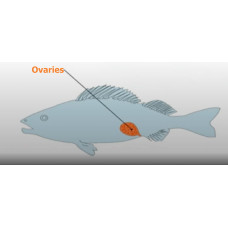The ovaries are the female reproductive organs in which eggs are formed and mature. In most fish, these organs are paired.
Hundreds or even millions of fertilised eggs can be present in a fish's ovary at any one time. Fresh eggs can develop from the germinal epithelium throughout life. Yellow bodies are found only in elasmobranch fishes; in other species the remnants of the follicle are rapidly absorbed by the ovary. The ovary of bony fishes often contains a hollow, lymph-filled space that opens into the oviduct, into which the eggs are deposited. Most normal female fish have two ovaries. In some elasmobranchs, only the right ovary is fully developed. Primitive jawless fishes and some bony fishes have only one ovary, formed by the fusion of paired organs in the embryo.
Fish ovaries can be of three types: gymnovarian, secondary gymnovarian or cystovarian. In the first type, eggs are released directly into the coelomic cavity, then enter the orifice, then through the oviduct and are excreted. Secondary gymnovarian ovaries release eggs into the coelomic cavity from which they enter the fallopian tube. In the third type, the eggs are discharged through the oviduct. Cystovaria is a primitive condition found in double-breathing fishes, sturgeons and bowfin fishes. Cystovaria are characteristic of most bony plants where the lumen of the ovary is continuous with the oviduct. Secondary gymnovaria are found in salmonids and some other bony fishes.
Ovaries
Tags: ovaries

